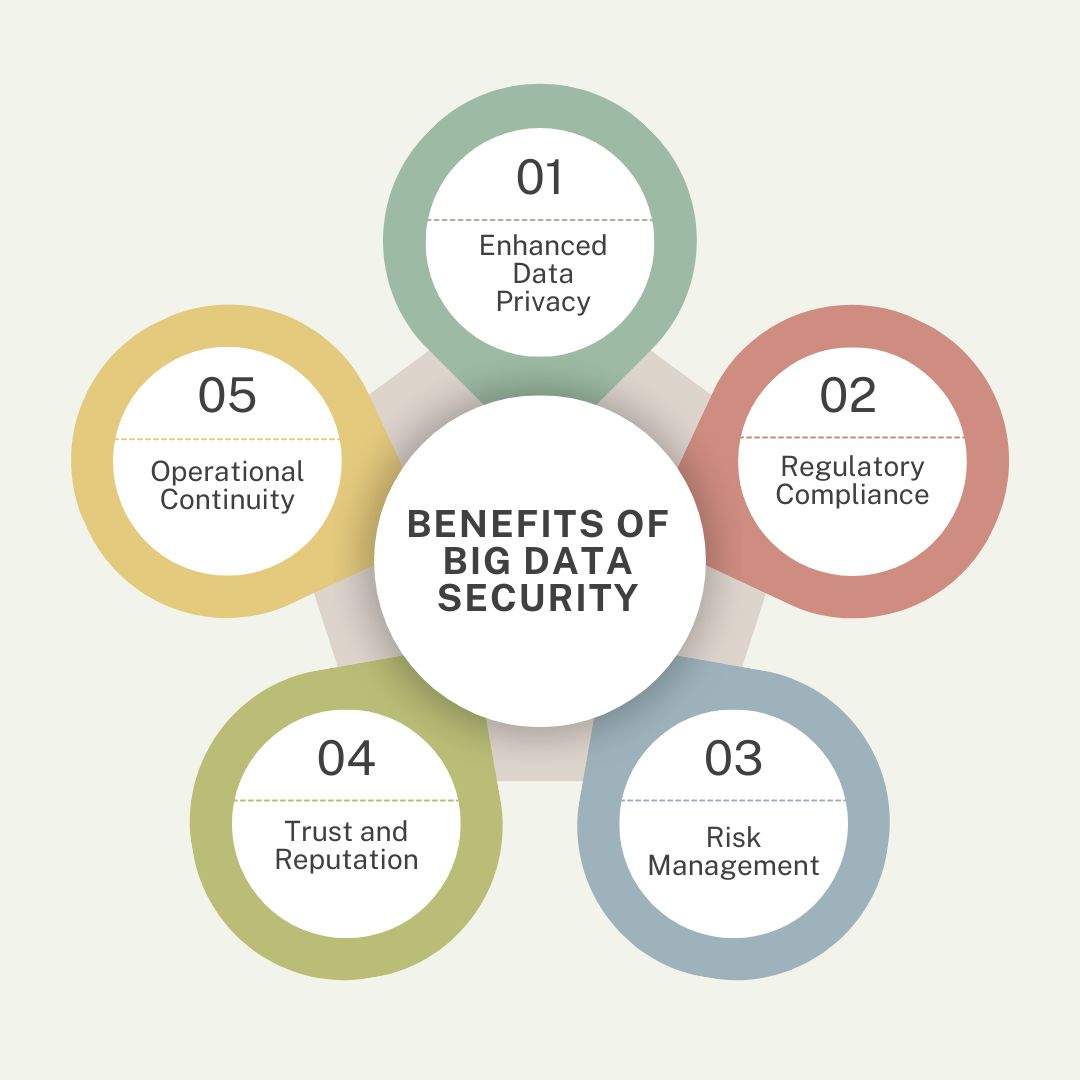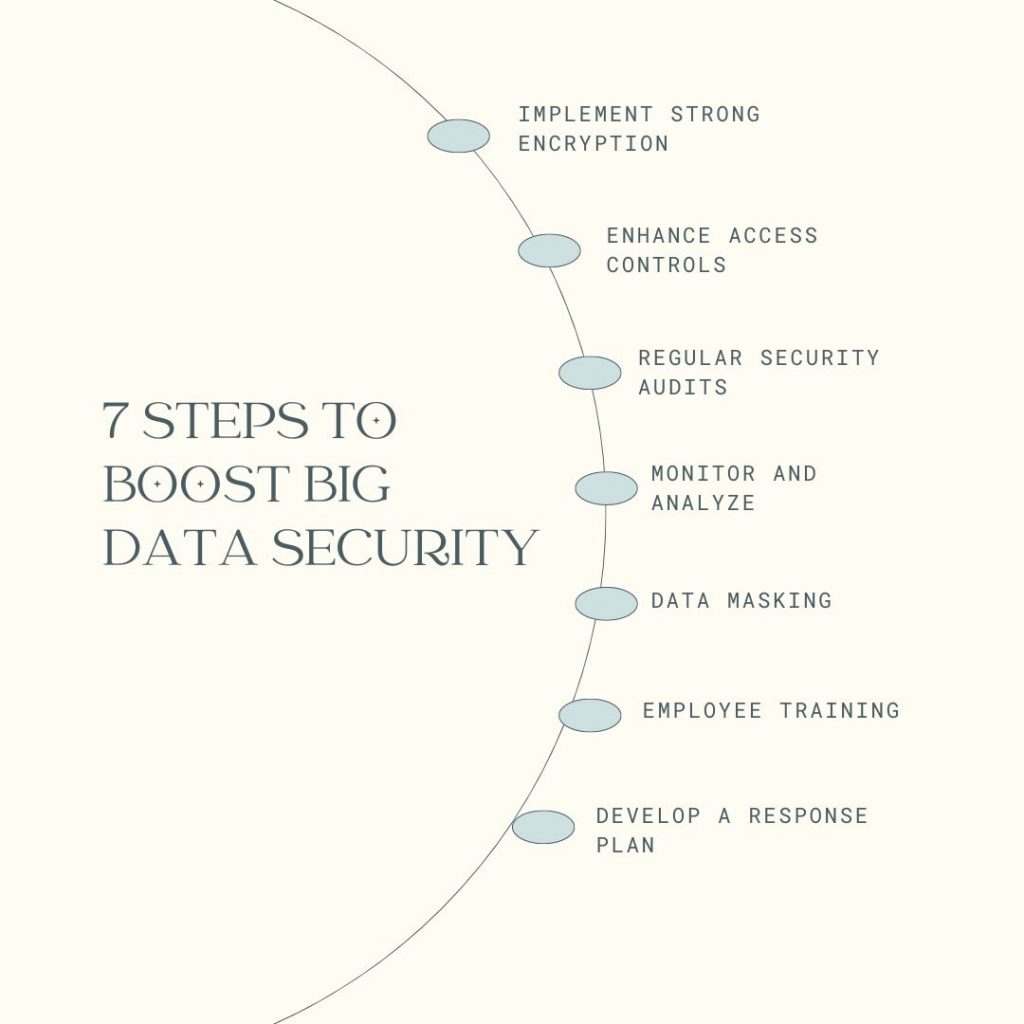
What is Big Data Security and How Does It Function?

We live in a world driven by data. From businesses making strategic decisions to individuals managing personal information, data is at the heart of everything. But as the amount of data grows, so do the risks. That’s where Big Data Security comes in—helping to protect sensitive information from cyber threats, breaches, and unauthorized access.
What Is Big Data Security?
Think of Big Data Security as a shield that safeguards massive amounts of information. It’s a combination of technologies and best practices designed to keep data safe—whether it’s stored, transmitted, or being processed. The goal? To ensure confidentiality, integrity, and availability, so organizations and individuals can trust that their data is secure.
To achieve this, businesses rely on methods like encryption, access controls, and monitoring to prevent cyber threats. These strategies help keep sensitive information safe while also ensuring compliance with security regulations.
Why Is Big Data Security So Important?
With the sheer volume of data being generated daily, security is no longer optional—it’s a necessity. Companies rely on data for everything from customer insights to business operations, making it critical to keep it safe from cybercriminals. Here’s why Big Data Security matters –
- Protects Customer Trust – A single data breach can ruin a company’s reputation. Strong security measures help maintain customer confidence.
- Prevents Financial Losses – Cyberattacks can lead to massive financial damages. Security breaches often come with hefty fines, lawsuits, and operational downtime.
- Ensures Compliance – Businesses must follow strict legal and regulatory frameworks to avoid penalties.
- Safeguards Intellectual Property – Companies store valuable trade secrets and sensitive information that need protection.
- Maintains Business Continuity – Reliable data security ensures that organizations can operate smoothly without disruptions caused by cyber incidents.
How Does Big Data Security Work?
Big Data Security isn’t just about having one solution—it’s about layering multiple defenses to create a strong security framework. Here are some of the key components –
- Encryption – Encrypting data makes it unreadable without a decryption key, keeping it safe even if intercepted.
- Access Controls – Restricting access ensures that only authorized personnel can view or modify sensitive data.
- Monitoring & Analytics – Continuous tracking of data access helps detect and prevent suspicious activities in real time.
- Data Masking – This technique hides sensitive information, making it accessible only when necessary for testing or analysis.
- Security Policies – Establishing clear security guidelines ensures that data is handled properly across the organization.
In today’s digital world, protecting big data is more than just a security measure—it’s a business priority. Organizations that invest in strong security frameworks not only prevent cyber threats but also build long-term trust with customers and stakeholders.
Benefits of Big Data Security

Big Data Security keeps sensitive information safe and ensures businesses follow important data regulations, reducing the chances of breaches. It helps build customer trust, protects a company’s reputation, and ensures smooth business operations by preventing cyber-attacks and data loss. Here’re several benefits of big data security –
Keeping Data Private and Secure
Think of Big Data Security as a digital lock that protects personal and proprietary information from unauthorized access. Whether it’s customer data, financial records, or trade secrets, keeping it confidential is essential. By securing data, businesses create a safe space where information can be collected and used responsibly—without putting anyone’s privacy at risk.
Staying Compliant with Regulations
Data protection laws like GDPR and HIPAA aren’t just guidelines—they’re mandatory for companies that handle sensitive data. Big Data Security ensures businesses meet these regulations, helping them avoid legal trouble and hefty fines. But beyond just following the rules, compliance shows that a company values ethical data practices, making it more trustworthy in the eyes of customers and stakeholders.
Reducing Risks and Preventing Breaches
Cyber threats are constantly evolving, and businesses need to stay ahead of the game. Big Data Security helps identify potential vulnerabilities before hackers can exploit them, minimizing the risk of breaches. A single security failure can lead to massive financial and reputational damage, so taking a proactive approach to data security is critical for long-term success.
Building Customer Trust and Protecting Reputation
Would you trust a company that suffered a major data breach? Probably not. Customers and partners expect businesses to handle their data responsibly. When companies invest in strong security measures, they not only protect sensitive information but also build lasting trust. And in a competitive market, trust can be a major factor in business growth.
Ensuring Smooth Business Operations
A security breach or data loss can bring business operations to a halt. Big Data Security keeps everything running smoothly, even when faced with cyber threats. By preventing disruptions, companies can focus on what matters most—growing their business and serving their customers without unexpected setbacks.
Top 5 Reasons for Increased Security Threats to Big Data
The sheer volume and speed at which big data is generated create both opportunities and challenges in keeping valuable insights and infrastructure secure. With evolving cyber threats and the risk of insider breaches, strong security measures are more important than ever.
Managing Data Volume and Speed
As data grows at an unprecedented rate, security solutions must keep up. Advanced technologies now allow real-time protection, ensuring that even as data scales in size and complexity, it remains safe from potential threats.
Securing Data from Diverse Sources
Big data comes from everywhere—traditional databases, social media, IoT devices, and more. Each source has its own vulnerabilities, making it crucial to use customized security strategies that protect data based on its unique risks.
Handling Complex Infrastructure
With cloud computing and IoT becoming an integral part of big data infrastructure, security must cover all layers of the system. A well-rounded approach helps minimize risks and strengthen protection across different platforms and environments.
Staying Ahead of Advanced Threats
Cyber threats are getting more sophisticated, from zero-day exploits to persistent attacks designed to evade traditional security measures. Organizations need proactive security strategies to detect and stop these threats before they cause harm.
Preventing Insider Risks
Security threats don’t always come from external hackers—sometimes, the biggest risks are internal. By implementing strict access controls and continuous monitoring, businesses can reduce the chances of insider threats, whether intentional or accidental.
Most Common Vulnerabilities in Big Data Security
Strengthening big data security starts with addressing common vulnerabilities—like improving access controls, enhancing encryption, and ensuring robust monitoring systems. By tackling these areas, businesses can better protect sensitive data and reduce the risk of potential threats like unauthorized access, theft, and breaches.
Weak Authentication and Authorization
To keep sensitive data safe, it’s crucial to have strong access controls. Improving authentication methods, such as using multi-factor authentication or role-based access control, makes sure only authorized users can access critical data, preventing any unauthorized access or potential threats.
Unsecured Data Transmission
Data in transit is just as vulnerable as data at rest. Encrypting data during transmission is essential to protect it from being intercepted by unauthorized parties. Using strong encryption protocols like SSL/TLS ensures that data remains secure as it moves between systems, safeguarding it against eavesdropping and theft.
Inadequate Data Masking
When testing or analyzing data, it’s important to protect sensitive information from exposure. Data masking techniques, such as pseudonymization and tokenization, ensure that sensitive data stays hidden during these processes, reducing the risk of unauthorized exposure in non-production environments.
Poor Monitoring
Constant vigilance is key to identifying potential security breaches before they escalate. Comprehensive monitoring systems, including intrusion detection and prevention systems (IDPS), provide real-time alerts to suspicious activity, allowing quick action to mitigate risks and minimize damage.
Insufficient Backup and Recovery
Data resilience is critical for business continuity, especially in the event of a cyber-attack. Having solid backup and recovery procedures in place ensures that data can be quickly restored after an incident, minimizing downtime and ensuring operations continue smoothly. Regular backups and a solid disaster recovery plan help maintain data availability, even during a crisis.
7 Steps to Boost Big Data Security

Big Data Security is all about protecting large datasets from unauthorized access and cyber threats, ensuring that data remains private, secure, and trustworthy. By putting the right strategies in place, organizations can safeguard their data during storage, transmission, and processing, all while keeping the trust and safety of everyone involved intact.
Implement Strong Encryption
To keep your data safe, use strong encryption methods both for data at rest and in transit. This ensures that even if data is intercepted, it stays unreadable without the proper decryption key. Using reliable encryption algorithms and secure key management is essential for maintaining confidentiality and keeping your data out of the wrong hands.
Enhance Access Controls
Controlling access to sensitive information is a must. Strict authentication and authorization measures ensure that only the right people can access critical data. By applying least-privilege access and regularly reviewing who has access to what, businesses can minimize the risk of unauthorized data breaches.
Regular Security Audits
Conducting regular security audits helps identify vulnerabilities and strengthen your defenses. Audits ensure that your security measures align with current standards and regulations while addressing any gaps that could expose your data to threats. Keeping your security infrastructure updated is key to staying one step ahead of potential attackers.
Monitor and Analyze
Continuous monitoring is essential for detecting unusual activities and potential breaches in real time. By analyzing usage patterns and security logs, businesses can spot threats early on, allowing them to respond quickly and reduce the impact of security incidents. Monitoring also helps uncover emerging vulnerabilities so they can be addressed proactively.
Data Masking
Data masking is a smart practice when handling sensitive data in non-production environments, like during testing and analysis. Masking helps keep sensitive information hidden from unauthorized users, reducing the risk of exposing it to threats in non-secure environments.
Employee Training
Your employees play a key role in securing data. Training staff on best security practices helps them avoid falling for phishing attacks or other social engineering tricks. Regular training sessions and awareness programs help create a culture of security within the organization, making everyone a line of defense against potential threats.
Develop a Response Plan
When a security breach happens, being prepared is half the battle. Developing and regularly updating a comprehensive incident response plan ensures that your team knows exactly how to handle security incidents. A good response plan includes clear steps for identifying, containing, and resolving issues quickly, as well as communication strategies to keep stakeholders informed. Having a well-prepared plan helps minimize the impact of security incidents and allows organizations to recover quickly.
Enhance Your Big Data Security Today!
Ensure your data is safe from breaches and attacks with our tailored Big Data Security solutions. Get comprehensive protection for your data infrastructure.
Secure Your Business Now
Conclusion
Big Data Security is essential for protecting valuable and sensitive information in today’s digital world. By putting strong security measures in place and staying alert to new threats, organizations can protect their data, maintain customer trust, and meet regulatory requirements.
Get in touch with our experts today.
FAQs
-
What do you mean by Big Data Security?
Big Data Security refers to the measures and technologies used to protect large volumes of data from unauthorized access, breaches, and other cyber threats. It involves ensuring the confidentiality, integrity, and availability of data by employing encryption, access controls, monitoring, and other security practices.
-
Why is security important in big data?
Security is crucial in big data to protect sensitive information from unauthorized access and cyber-attacks. It helps maintain customer trust, ensures compliance with data protection regulations, prevents financial and reputational damage from data breaches, and safeguards intellectual property and other critical assets.
-
What are the 3 types of data security?
Physical Security: Protects the hardware and physical infrastructure where data is stored and processed, such as data centers and servers. Network Security: Safeguards data during transmission over networks, including the use of firewalls, intrusion detection systems, and secure communication protocols. Application Security: Ensures that software applications handling data are secure from vulnerabilities and exploits through practices like code reviews, penetration testing, and secure coding standards.
-
How to secure data in big data?
To secure data in big data, organizations should implement several key strategies: Use Robust Encryption: Protect data at rest and in transit with strong encryption methods. Enhance Access Controls: Apply strict authentication and authorization measures to limit access to sensitive data. Conduct Regular Security Audits: Regularly audit security measures to identify and address vulnerabilities. Continuous Monitoring: Monitor data access and usage patterns to detect and respond to anomalies in real-time. Implement Data Masking: Mask sensitive data during non-production processes to prevent exposure. Employee Training: Educate employees on security best practices and the importance of data protection. Develop a Response Plan: Establish a comprehensive incident response plan to address and mitigate security breaches quickly.

About Author
Jayanti Katariya is the CEO of BigDataCentric, a leading provider of AI, machine learning, data science, and business intelligence solutions. With 18+ years of industry experience, he has been at the forefront of helping businesses unlock growth through data-driven insights. Passionate about developing creative technology solutions from a young age, he pursued an engineering degree to further this interest. Under his leadership, BigDataCentric delivers tailored AI and analytics solutions to optimize business processes. His expertise drives innovation in data science, enabling organizations to make smarter, data-backed decisions.
Table of Contents
Toggle